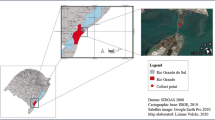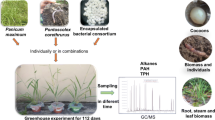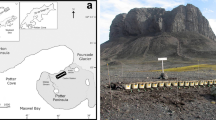Abstract
Unconventional oils such as diluted bitumen from oil sands differs from most of conventional oils in terms of physiochemical properties and PAHs composition. This raises concerns regarding the effectiveness of current remediation strategies and protocols originally developed for conventional oil. Here we evaluated the efficiency of different biotreatment approaches, such as fungi inoculation (bioaugmentation), sludge addition (bioaugmentation/biostimulation), perennial grasses plantation (phytoremediation) and their combinations as well as natural attenuation (as control condition), for the remediation of soil contaminated by synthetic crude oil (a product of diluted bitumen) in laboratory microcosms. We specifically monitored the PAHs loss percentage (alkylated PAHs and unsubstituted 16 EPA Priority PAHs), the residue of PAHs and evaluated the ecotoxicity of soil after treatment. All treatments were highly efficient with more than ~ 80% of ∑PAHs loss after 60 days. Distinctive loss efficiencies between light PAHs (≤ 3 rings, ~ 96% average loss) and heavy PAHs (4–6 rings, ~ 29% average loss) were observed. The lowest average PAHs residue (0.10 ± 0.02 mg·kg−1, for an initial concentration of 0.29 ± 0.12 mg·kg−1) was achieved with the “sludge—plants (grasses)” combination. Sludge addition was the only treatment that achieved significantly lower ecotoxicity (3% ± 4% of growth inhibition of L. sativa) than the control (natural attenuation, 13% ± 4% of inhibition). Sludge addition, grasses plantation and “sludge—fungi combination” treatments could result in lower PAH exposure (than other treatments) in post-treated soil when using the Canadian Soil Quality Guidelines for the protection of environmental and human health for potentially carcinogenic and other PAHs.





Similar content being viewed by others
Data Availability
Please contact the corresponding author.
Code availability
Not applicable.
References
Abena MTB, Li T, Shah MN, Zhong W (2019) Biodegradation of total petroleum hydrocarbons (TPH) in highly contaminated soils by natural attenuation and bioaugmentation. Chemosphere 234:864–874. https://doi.org/10.1016/j.chemosphere.2019.06.111
Aislabie J, Balks M, Astori N et al (1999) Polycyclic aromatic hydrocarbons in fuel-oil contaminated soils, Antarctica. Chemosphere 39:2201–2207
Amponsah NY, Wang J, Zhao L (2018) A review of life cycle greenhouse gas (GHG) emissions of commonly used ex-situ soil treatment technologies. J Clean Prod 186:514–525. https://doi.org/10.1016/j.jclepro.2018.03.164
Andersson JT, Achten C (2015) Time to Say Goodbye to the 16 EPA PAHs? Toward an Up-to-Date Use of PACs for Environmental Purposes. Polycycl Aromat Comp 35(2–4):330–354. https://doi.org/10.1080/10406638.2014.991042
Andreote FD, de Silva M, CP et al (2017) Microbial communities associated with plants: learning from nature to apply it in agriculture. Curr Opin Microbiol 37:29–34. https://doi.org/10.1016/j.mib.2017.03.011
ASTM (2019a) C136 / C136M-19, Standard Test Method for Sieve Analysis of Fine and Coarse Aggregates, ASTM International, West Conshohocken, PA. http://www.astm.org
ASTM (2019b) D2216–19, Standard Test Methods for Laboratory Determination of Water (Moisture) Content of Soil and Rock by Mass, ASTM International, West Conshohocken, PA, 2019, http://www.astm.org
Augulyte L, Kliaugaite D, Racys V et al (2009) Multivariate analysis of a biologically activated carbon (BAC) system and its efficiency for removing PAHs and aliphatic hydrocarbons from wastewater polluted with petroleum products. J Hazard Mater 170:103–110. https://doi.org/10.1016/j.jhazmat.2009.04.129
Baird SJ, Bailey EA, Vorhees DJ (2007) Evaluating human risk from exposure to alkylated PAHs in an aquatic system. Hum Ecol Risk Assess 13:322–338
Beaulieu M (2016) Guide d’intervention - Protection des sols et réhabilitation des terrains contaminés. Ministère de l’Environnement et de la Lutte contre les changements climatiques QC Canada
Beck T, Gáper J, Šebesta M, Gáperová S (2018) Host preferences of wood-decaying fungi of the genus Ganoderma in the urban areas of Slovakia. Annales Universitatis Paedagogicae Cracoviensis Studia Naturae 22–37
Beyer J, Trannum HC, Bakke T et al (2016) Environmental effects of the Deepwater Horizon oil spill: a review. Mar Pollut Bull 110:28–51
Bojes HK, Pope PG (2007) Characterization of EPA’s 16 priority pollutant polycyclic aromatic hydrocarbons (PAHs) in tank bottom solids and associated contaminated soils at oil exploration and production sites in Texas. Regul Toxicol Pharmacol 47:288–295
Brischke C, Wegener FL (2019) Impact of water holding capacity and moisture content of soil substrates on the moisture content of wood in terrestrial microcosms. Forests 10:485. https://doi.org/10.3390/f10060485
Camenzuli D, Freidman BL, Statham TM et al (2013) On-site and in situ remediation technologies applicable to metal-contaminated sites in Antarctica and the Arctic: a review. Polar Res. https://doi.org/10.3402/polar.v33.21522
CCME (2010b) Canadian Soil Quality Guidelines for Carcinogenic and Other Polycyclic Aromatic Hydrocarbons (Environmental and Human Health Effects). Canadian Council of Ministers of the Environment
CCME (2010a) Canadian Soil Quality Guidelines for the Protection of Environmental and Human Health: Polycyclic aromatic hydrocarbons. Canadian Council of Ministers of the Environment
Cerniglia CE, Heitkamp MA (1989) Microbial Degradation of polycyclic aromatic hydrocarbons (PAHs) in the aquatic environment. CRC Press
Cho B-H, Chino H, Tsuji H et al (1997) Laboratory-scale bioremediation of oil-contaminated soil of Kuwait with soil amendment materials. Chemosphere 35:1599–1611
Collins JF, Brown JP, Alexeeff GV, Salmon AG (1998) Potency equivalency factors for some polycyclic aromatic hydrocarbons and polycyclic aromatic hydrocarbon derivatives. Regul Toxicol Pharmacol 28:45–54. https://doi.org/10.1006/rtph.1998.1235
Cornelissen G, Gustafsson Ö, Bucheli TD et al (2005) Extensive sorption of organic compounds to black carbon, coal, and kerogen in sediments and soils: mechanisms and consequences for distribution, bioaccumulation, and biodegradation. Environ Sci Technol 39:6881–6895
Coulon F, Pelletier E, Gourhant L, Delille D (2005) Effects of nutrient and temperature on degradation of petroleum hydrocarbons in contaminated sub-Antarctic soil. Chemosphere 58:1439–1448
Couto N, García-Frutos FJ (2016) Biological Techniques to Remediate Petroleum Hydrocarbons in Contaminated Environments. Soil Remediation: Applications and New Technologies, 139.
Davoodi SM, Miri S, Taheran M et al (2020) Bioremediation of unconventional oil contaminated ecosystems under natural and assisted conditions: a review. Environ Sci Technol 54:2054–2067. https://doi.org/10.1021/acs.est.9b00906
de Boer W (2017) Upscaling of fungal–bacterial interactions: from the lab to the field. Curr Opin Microbiol 37:35–41. https://doi.org/10.1016/j.mib.2017.03.007
de Santiago-Martín A, Guesdon G, Díaz-Sanz J, Galvez-Cloutier R (2015) Oil spill in Lac-Mégantic Canada: environmental monitoring and remediation. Int J Water Wastewater Treat. https://doi.org/10.16966/2381-5299.113
Deshpande RS, Sundaravadivelu D, Techtmann S et al (2018) Microbial degradation of Cold Lake Blend and Western Canadian select dilbits by freshwater enrichments. J Hazard Mater 352:111–120. https://doi.org/10.1016/j.jhazmat.2018.03.030
Deuren JV, Lloyd T, Chhetry S, et al (2002) Remediation Technologies Screening Matrix and Reference Guide, 4th Edition (OMB No. 0704–0188)
Dew WA, Hontela A, Rood SB, Pyle GG (2015) Biological effects and toxicity of diluted bitumen and its constituents in freshwater systems. J Appl Toxicol 35:1219–1227. https://doi.org/10.1002/jat.3196
Dores-Silva PR, Cotta JAO, Landgraf MD, Rezende MOO (2018) Soils impacted by PAHs: would the stabilized organic matter be a green tool for the immobilization of these noxious compounds? J Environ Sci Heal Part B 53:1–6. https://doi.org/10.1080/03601234.2018.1431461
Enell A, Reichenberg F, Warfvinge P, Ewald G (2004) A column method for determination of leaching of polycyclic aromatic hydrocarbons from aged contaminated soil. Chemosphere 54:707–715. https://doi.org/10.1016/j.chemosphere.2003.08.026
Fang GC, Chang KF, Lu C, Bai H (2004) Estimation of PAHs dry deposition and BaP toxic equivalency factors (TEFs) study at Urban, Industry Park and rural sampling sites in central Taiwan, Taichung. Chemosphere 55:787–796. https://doi.org/10.1016/j.chemosphere.2003.12.012
Ferguson DK, Li C, Jiang C et al (2020) Natural attenuation of spilled crude oil by cold-adapted soil bacterial communities at a decommissioned High Arctic oil well site. Sci Total Environ 722:e137258. https://doi.org/10.1016/j.scitotenv.2020.137258
French HK, van der Zee SEATM, Meju M (2009) SoilCAM: soil contamination: advanced integrated characterisation and time-lapse monitoring. Rev Environ Sci Biotechnol 8:125–130. https://doi.org/10.1007/s11157-009-9158-y
Gallego JLR, Sierra C, Permanyer A et al (2011) Full-scale remediation of a jet fuel-contaminated soil: assessment of biodegradation, volatilization, and bioavailability. Water Air Soil Pollut 217:197–211
Galvez-Cloutier R, Guesdon G, Fonchain A (2014) Lac-Mégantic: analyse de l’urgence environnementale, bilan et évaluation des impacts. Can J Civil Eng 41:531–539. https://doi.org/10.1139/cjce-2014-0011
Glick BR (2010) Using soil bacteria to facilitate phytoremediation. Biotechnol Adv 28:367–374. https://doi.org/10.1016/j.biotechadv.2010.02.001
Griffiths RA (1995) Soil-washing technology and practice. J Hazard Mater 40:175–189
Gupta G, Kumar V, Pal AK (2017) Microbial degradation of high molecular weight polycyclic aromatic hydrocarbons with emphasis on pyrene. Polycycl Aromat Comp 39:1–13. https://doi.org/10.1080/10406638.2017.1293696
Haroune L, Saibi S, Bellenger JP, Cabana H (2014) Evaluation of the efficiency of Trametes hirsuta for the removal of multiple pharmaceutical compounds under low concentrations relevant to the environment. Bioresource Technol 171:199–202. https://doi.org/10.1016/j.biortech.2014.08.036
Hawthorne SB, Grabanski CB, Miller DJ (2006) Measured partitioning coefficients for parent and alkyl polycyclic aromatic hydrocarbons in 114 historically contaminated sediments: part 1. KOC Values Environ Toxicol Chem 25:2901–2911. https://doi.org/10.1897/06-115r.1
Hazalin NA, Ramasamy K, Lim SM et al (2009) Cytotoxic and antibacterial activities of endophytic fungi isolated from plants at the National Park, Pahang. Malaysia Bmc Complem Altern M 9:46. https://doi.org/10.1186/1472-6882-9-46
Hoffman DJ, Gay ML (1981) Embryotoxic effects of benzo [a] pyrene, chrysene, and 7, 12-dimethylbenz [a] anthracene in petroleum hydrocarbon mixtures in mallard ducks. J Toxicol Environ Health Part A 7:775–787
Hwang S, Cutright TJ (2002) Impact of clay minerals and DOM on the competitive sorption/desorption of PAHs. Soil and Sediment Contamination 11:269–291
IARC (2002) Some traditional herbal medicines, some mycotoxins, naphthalene and styrene. Iarc Monogr Eval Carcinog Risks Humans World Heal Organ Int Agency Res Cancer 82:1–556
Islam MN, Jo Y-T, Park J-H (2014) Remediation of soil contaminated with lubricating oil by extraction using subcritical water. J Ind Eng Chem 20:1511–1516
ISO (2012) Soil Quality-Determination of Effects of Pollutants on Soil Flora Part 2: Effects of Chemicals on the Emergence and Growth of Higher Plants. ISO, Geneva
Jain P, Gupta V, Gaur R et al (2011) Bioremediation of petroleum oil contaminated soil and water. Res J Environ Toxicol 5:1–26
Johansson I, Bavel BV (2003) Levels and patterns of polycyclic aromatic hydrocarbons in incineration ashes. Sci Total Environ 311:221–231
Joner E, Corgie S, Amellal N, Leyval C (2002) Nutritional constraints to degradation of polycyclic aromatic hydrocarbons in a simulated rhizosphere. Soil Biol Biochem 34:859–864
Jørgensen K, Puustinen J, Suortti A-M (2000) Bioremediation of petroleum hydrocarbon-contaminated soil by composting in biopiles. Environ Pollut 107:245–254
Kang H-J, Lee S-Y, Kwon J-H (2016) Physico-chemical properties and toxicity of alkylated polycyclic aromatic hydrocarbons. J Hazard Mater 312:200–207
Keith LH (2015) The source of US EPA’s sixteen PAH priority pollutants. Polycyclic Aromat Compd 35:147–160
Kingston PF (2002) Long-term environmental impact of oil spills. Spill Sci Technol Bull 7:53–61
Law RJ, Kelly C, Baker K et al (2002) Toxic equivalency factors for PAH and their applicability in shellfish pollution monitoring studies. J Environ Monitor 4:383–388. https://doi.org/10.1039/b200633m
Li X, Li P, Lin X et al (2008) Biodegradation of aged polycyclic aromatic hydrocarbons (PAHs) by microbial consortia in soil and slurry phases. J Hazard Mater 150:21–26
Lim MW, Lau EV, Poh PE (2016) A comprehensive guide of remediation technologies for oil contaminated soil—present works and future directions. Mar Pollut Bull 109:14–45
MicroBioTests, (2004) PHYTOTOXKIT - Seed germination and early growth microbiotest with higher plants - Standard operation procedure. MicroBioTests Inc., Mariakerke (Gent), Belgium
NAS (2016) Spills of Diluted Bitumen from Pipelines: A Comparative Study of Environmental Fate, Effects, and Response. National Academies of Sciences, Engineering, Medicine (NAS), Washington, DC
NEB (2013) Canada’s Energy Future 2013 - Energy Supply and Demand Projections to 2035 - An Energy Market Assessment. National Energy Board (NEB)
Nisbet IC, LaGoy PK (1992) Toxic equivalency factors (TEFs) for polycyclic aromatic hydrocarbons (PAHs). Regul Toxicol Pharm 16:290–300. https://doi.org/10.1016/0273-2300(92)90009-x
OSM, Oil Sands Magazine (2020) Bitumen upgrading explained. https://www.oilsandsmagazine.com/technical/bitumen-upgrading#PDF. Accessed 3 Apr 2021
Phillips L, Greer C, Germida J (2006) Culture-based and culture-independent assessment of the impact of mixed and single plant treatments on rhizosphere microbial communities in hydrocarbon contaminated flare-pit soil. Soil Biology Biochem 38:2823–2833. https://doi.org/10.1016/j.soilbio.2006.04.038
Richter RB, Flachberger H (2010) Soil Washing and thermal desorption: reliable techniques for remediating materials contaminated with mercury. BHM Berg- Huettenmaenn Monatsh 155:571–577. https://doi.org/10.1007/s00501-010-0617-0
Richter-Brockmann S, Achten C (2018) Analysis and toxicity of 59 PAH in petrogenic and pyrogenic environmental samples including dibenzopyrenes, 7H-benzo [c] fluorene, 5-methylchrysene and 1-methylpyrene. Chemosphere 200:495–503
Sabaté J, Vinas M, Solanas A (2004) Laboratory-scale bioremediation experiments on hydrocarbon-contaminated soils. Int Biodeterior Biodegradation 54:19–25
Samaksaman U, Peng T-H, Kuo J-H et al (2016) Thermal treatment of soil co-contaminated with lube oil and heavy metals in a low-temperature two-stage fluidized bed incinerator. Appl Therm Eng 93:131–138
Sanz JD (2015) Bioremediation of urban soils polluted with non-conventional petroleum in the Canadian context. (Master’s thesis, the name of the Complutense University, Madrid, Spain). Retrieved from http://hdl.handle.net/10017/25998
Satapanajaru T, Anurakpongsatorn P, Pengthamkeerati P, Boparai H (2008) Remediation of atrazine-contaminated soil and water by nano zerovalent iron. Water Air Soil Pollut 192:349–359
Shahsavari E, Schwarz A, Aburto-Medina A, Ball AS (2019) Biological degradation of polycyclic aromatic compounds (PAHs) in soil: a current perspective. Curr Pollut Reports 5:84–92. https://doi.org/10.1007/s40726-019-00113-8
Shi X, Ji L, Zhu D (2010) Investigating roles of organic and inorganic soil components in sorption of polar and nonpolar aromatic compounds. Environ Pollut 158:319–324
Slegrist RL, Phelps TJ, Korte NE, Pickering DA (1994) Characterization and biotreatability of petroleum contaminated soils in a coral atoll in the Pacific Ocean. Appl Biochem Biotechnol 45:757–773
Swift A, Casey-Lefkowitz S, Shope E, Club S (2011) Tar Sands Pipelines Safety Risks. Natural Resources Defense Council (NRDC), New York: Retrieved from https://iaac-aeic.gc.ca
Tatàno F, Felici F, Mangani F (2013) Lab-Scale Treatability tests for the thermal desorption of hydrocarbon-contaminated soils. Soil Sediment Contam Int J 22:433–456. https://doi.org/10.1080/15320383.2013.721814
Teal JM, Howarth RW (1984) Oil spill studies: a review of ecological effects. Environ Manage 8:27–43
Troxler WL, Cudahy JJ, Zink RP et al (1993) Treatment of nonhazardous petroleum-contaminated soils by thermal desorption technologies. Air Waste 43:1512–1525
USEPA (1996) Ecological effects test guidelines: Seed germination/root elongation toxicity test (OPPTS 850.4200)
USEPA (2004) Cleaning Up the Nation’s Waste Sites: Markets and Technology Trends (EPA 542-R-04–015). Office of Solid Waste And Emergency Response, Washington D.C.
van der Heijden MG, de Bruin S, Luckerhoff L et al (2016) A widespread plant-fungal-bacterial symbiosis promotes plant biodiversity, plant nutrition and seedling recruitment. Isme J 10:389–399. https://doi.org/10.1038/ismej.2015.120
Varanasi U (1989) Metabolism of polycyclic aromatic hydrocarbons in the aquatic environment. CRC Press
Wang XT, Miao Y, Zhang Y et al (2013) Polycyclic aromatic hydrocarbons (PAHs) in urban soils of the megacity Shanghai: occurrence, source apportionment and potential human health risk. Sci Total Environ 447:80–89. https://doi.org/10.1016/j.scitotenv.2012.12.086
Wang M, Wang C, He S (2015) Source identification of oil spills using compound-specific carbon isotope analysis based on “7–16” oil spill in Dalian, China. Aquat Pr 3:197–202. https://doi.org/10.1016/j.aqpro.2015.02.211
Whyte L, Goalen B, Hawari J et al (2001) Bioremediation treatability assessment of hydrocarbon-contaminated soils from Eureka, Nunavut. Cold Reg Sci Technol 32:121–132
Wilson SC, Jones KC (1993) Bioremediation of soil contaminated with polynuclear aromatic hydrocarbons (PAHs): a review. Environ Pollut 81:229–249
Wu M, Wu J, Zhang X, Ye X (2019) Effect of bioaugmentation and biostimulation on hydrocarbon degradation and microbial community composition in petroleum-contaminated loessal soil. Chemosphere 237:e124456. https://doi.org/10.1016/j.chemosphere.2019.124456
Yang C, Wang Z, Yang Z et al (2011) Chemical Fingerprints of Alberta Oil Sands and Related Petroleum Products. Environ Forensics 12:173–188. https://doi.org/10.1080/15275922.2011.574312
Yang Y, Zhang N, Xue M et al (2011) Effects of soil organic matter on the development of the microbial polycyclic aromatic hydrocarbons (PAHs) degradation potentials. Environ Pollut 159:591–595
Yang C, Zhang G, Wang Z et al (2014) Development of a methodology for accurate quantitation of alkylated polycyclic aromatic hydrocarbons in petroleum and oil contaminated environmental samples. Anal Methods-Uk 6:7760–7771. https://doi.org/10.1039/c4ay01393j
Yang Z, Shah K, Fieldhouse B et al (2021) Characterization, occurrence and natural attenuation of spilled light synthetic crude oil in a boreal freshwater ecosystem. Fuel 285:e119276
Ye S, Zeng G, Wu H et al (2017) Biological technologies for the remediation of co-contaminated soil. Crit Rev Biotechnol 37:1062–1076
Acknowledgements
This study was supported by a NSERC strategic partnership grants (CG113698) and a NSERC discovery grant (RGPIN-2016-03660). The authors also thank the review and helpful comments given by Maximiliano Cledon.
Funding
This study was supported by a NSERC strategic partnership Grant No. (CG113698) and a NSERC discovery Grant No. (RGPIN-2016–03660).
Author information
Authors and Affiliations
Corresponding author
Ethics declarations
Conflicts of interest
The authors declare that they have no known competing financial interests or personal relationships that could have appeared to influence the work reported in this paper.
Additional information
Publisher's Note
Springer Nature remains neutral with regard to jurisdictional claims in published maps and institutional affiliations.
Supplementary Information
Below is the link to the electronic supplementary material.
Rights and permissions
About this article
Cite this article
Li, Z., Cabana, H., Lecka, J. et al. Efficiencies of selected biotreatments for the remediation of PAH in diluted bitumen contaminated soil microcosms. Biodegradation 32, 563–576 (2021). https://doi.org/10.1007/s10532-021-09952-z
Received:
Accepted:
Published:
Issue Date:
DOI: https://doi.org/10.1007/s10532-021-09952-z




